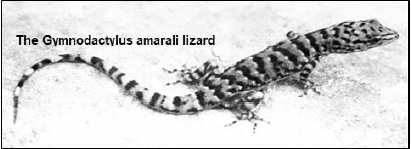Life Sciences Paper 2 Questions - Grade 12 September 2021 Preparatory Exams
Share via Whatsapp Join our WhatsApp Group Join our Telegram GroupINSTRUCTIONS AND INFORMATION
Read the following instructions carefully before answering the questions.
- Answer ALL the questions.
- Write ALL the answers in the ANSWER BOOK or PAPER provided.
- Start the answer to EACH question at the top of a NEW page.
- Number the answers correctly according to the numbering system used in this question paper.
- Present your answers according to the instructions of each question.
- ALL drawings MUST be done in pencil and labelled in blue or black ink.
- Draw diagrams, tables or flow charts ONLY when asked to do so.
- The diagrams in this question paper are NOT necessarily drawn to scale.
- Do NOT use graph paper.
- You must use a non-programmable calculator, protractor and a compass, where necessary.
- All calculations to be rounded off to TWO decimal spaces.
- Write neatly and legibly.
QUESTIONS
SECTION A
QUESTION 1
1.1 Various options are provided as possible answers to the following questions. Choose the correct answer and write only the letter (A–D) next to the question numbers (1.1.1 to 1.1.10) in the ANSWER BOOK, for example 1.1.11 D.
1.1.1 Which ONE of the following describes the natural shape of the DNA molecule?
- It has a sugar-phosphate frame
- It is double stranded
- It has a double helix structure
- It has complementary nucleotides
1.1.2 The diagram below represents different phases of meiosis.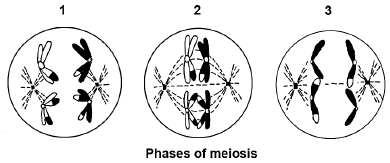
The correct order in which the phases occur is …
- 1, 2, 3.
- 3, 2, 1.
- 1, 3, 2.
- 2, 1, 3.
1.1.3 The pedigree diagram below shows the inheritance of cystic fibrosis which is controlled by a recessive allele, in a certain family.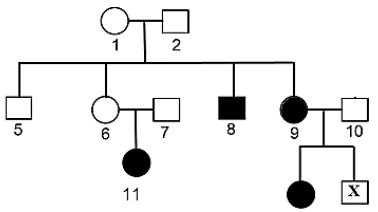
Which ONE of the following is the phenotype for individual X?
- Unaffected male
- Affected male
- Unaffected female
- ffected female
1.1.4 On the Galapagos islands there are 13 species of finches on different islands. Scientists believe that they all originated from a common ancestor that came from the mainland.
Which ONE of the following factors caused the first step in the evolution of the 13 finch species from a common ancestor?
- Breeding at different times of the year
- Geographical separation by the sea
- Producing infertile offspring
- Natural selection
1.1.5 Curly hair is dominant over straight hair. A woman who is homozygous for curly hair marries a man homozygous for straight hair.
What is the possibility of them producing a child with straight hair?
- 25%
- 50%
- 100%
- 0%
1.1.6 A man who has blood group A and a woman who has blood group O have a child together.
Which ONE of the following is the blood group genotype of the child?
- ii
- IAIB
- IAIA
- IBi
1.1.7 Which ONE of the following will occur during meiosis I?
- Chromatids separate to opposite poles
- Identical haploid cells form
- Non-disjunction
- Alleles of a gene fuse together
1.1.8 Which ONE of the following is correct about mitochondrial DNA (mt-DNA)?
- It is passed on from father to offspring
- It can be used to determine female ancestry
- It can be used to determine male ancestors of female individuals
- It traces the oldest male ancestors to Africa
1.1.9 Haemophilia is a sex-linked recessive disorder in humans. A father and his son both have haemophilia, but the mother is normal. Her genotype will be …
- XhXh
- XHXh
- XHXH
- XhY
1.1.10 What will the percentage of guanine be in a DNA molecule, if 20% of the nitrogenous bases are adenine?
- 20%
- 30%
- 40%
- 60% (10 x 2) (20)
1.2 Give the correct biological term for EACH of the following descriptions. Write only the term next to the question numbers (1.2.1–1.2.8) in the ANSWER BOOK.
1.2.1 The physical or functional expression of a gene
1.2.2 The non-sex chromosomes
1.2.3 The point at which chromatids overlap during crossing over
1.2.4 A section of a DNA molecule that codes for a specific characteristic
1.2.5 The process during which mRNA is produced during protein synthesis
1.2.6 The production of a genetically identical copy of an organism using biotechnology
1.2.7 Chromosomes that carry the same set of genes
1.2.8 The position where a particular gene is found on a chromosome (8 x 1) (8)
1.3 Indicate whether each of the statements in COLUMN Ι, applies to A ONLY, B ONLY, BOTH A and B, or NONE of the items in COLUMN ΙΙ. Write A only, B only, both A and B, or none next to the question numbers (1.3.1 to 1.3.3) in the ANSWER BOOK.
COLUMN Ι | COLUMN ΙΙ | |
1.3.1 Type of inheritance where neither of the two alleles is dominant over the other and an intermediate phenotype is produced | A: B: | Co-dominance Incomplete dominance |
1.3.2 An example of a reproductive isolation mechanism | A: | Species-specific courtship behaviour |
| B: | Prevention of fertilisation | |
1.3.3 The number of alleles that control the human blood group | A: | Two |
B: | Three | |
(3 x 2) (6)
1.4 The diagram below represents a cell during cell division.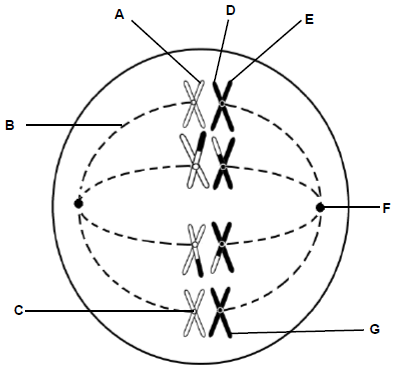
1.4.1 Name the type of cell division shown in the diagram above. (1)
1.4.2 Identify the phase represented by this diagram. (1)
1.4.3 Give the LETTER/S that represent/s:
- The structure that moves/pulls chromosomes/chromatids to the poles during cell division (1)
- The part that is responsible for forming the spindle fibres (1)
- TWO chromatids that are identical (2)
1.4.4 How many chromosomes will be found in each daughter cell at the end of this cell division? (1)
1.4.5 Give the name of the cells that will be formed as a result of this type of cell division in a male. (1)
1.5 The diagrams below represent three ideas proposed to explain evolution.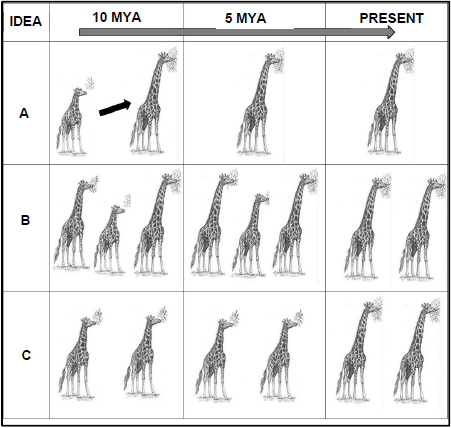
1.5.1 What does MYA stand for? (1)
1.5.2 Give the LETTER of the diagram (A, B or C) that would best represent:
- Punctuated equilibrium (1)
- Lamarck’s explanation of evolution if there was an environmental change 10mya (1)
- Charles Darwin’s explanation of evolution (1)
1.5.3 State a reason why the ‘theory of evolution’ is regarded as a scientific theory. (1)
1.5.4 Name THREE lines of evidence used to support the theory of evolution. (3)
TOTAL SECTION A: 50
SECTION B
QUESTION 2
2.1 The diagrams below show two forms of a chromosome.
2.1.1 Identify part A. (1)
2.1.2 Identify the process that led to the formation of the chromosome represented by Diagram 2. (1)
2.1.3 Describe the process mentioned in QUESTION 2.1.2. (4)
2.1.4 Give TWO reasons why the process described in QUESTION 2.1.3 is important. (2)
2.2 When a tsunami destroyed a town in Japan, several people went missing. A baby that was rescued from the ruins was claimed by three sets of parents. DNA tests were done to determine the parents of the baby.
Below are the results of the DNA test: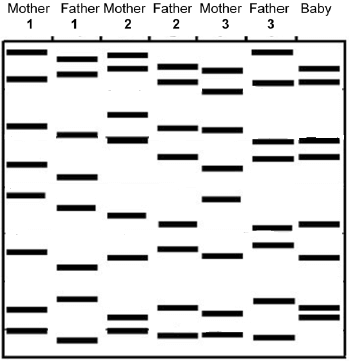
2.2.1 Which set of parents (set 1, 2 or 3) are the biological parents of the baby? (1)
2.2.2 Give a reason for you answer to QUESTION 2.2.1. (2)
2.2.3 Name TWO sources of DNA the police could use to produce a DNA profile. (2)
2.2.4 Mention TWO other uses of DNA profiling apart from the one mentioned above. (2)
2.3 Haemoglobin-A is a normal protein in red blood cells that transports oxygen. A mutation sometimes occurs in the gene that codes for this protein, where thymine is replaced by adenine at a single point. This mutation results in the formation of a different protein called haemoglobin-S.
Haemoglobin-S causes red blood cells to become stiff and sickle-shaped. The sickle-shaped red blood cells cause blockages in the blood vessel. A person will have sickle-cell disease. Currently the only cure for sickle cell disease is bone marrow transplants and stem cell treatment.
The diagram below shows the red blood cell shape and DNA sequence for haemoglobin-A and haemoglobin-S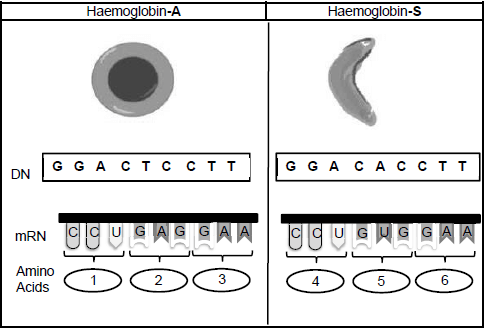
2.3.1 State a reason why sickle cell disease is dangerous. (1)
2.3.2 What are stem cells? (2)
2.3.3 Use the table below to answer the following questions.
Amino Acid | tRNA anticodon |
Leucine | GAA |
Lycine | CUU |
Glycine | GGA |
Glutamic acid | GAG |
Histidine | GUA |
Methionine | UAC |
Proline | CCU |
Valine | CAC |
Glutamine | CUC |
- Give the anticodon for amino acid 6. (1)
- Name amino acid 1. (1)
- Explain how this mutation in the haemoglobin gene affects the amino acid sequence formed. (4)
2.3.4 The allele for haemoglobin-A is dominant (H) over that for haemoglobin-S (h). A man homozygous for haemoglobin-A has a child with a heterozygous female. Use a genetic cross to show the possibility of them having a child with haemoglobin-S. (6)
[15]
2.4 The diagrams below show the chromosomes in the cells of two individuals.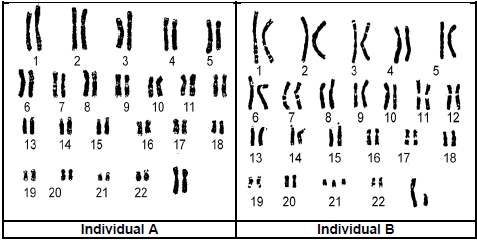
2.4.1 Name the type of diagram shown above. (1)
2.4.2 State why it can be concluded that diagram A belongs to a female. (2)
2.4.3 State why the diagrams above show the chromosomes of a somatic cell and not a gamete. (2)
2.4.4 Name the disorder that individual B has. (1)
2.4.5 Describe the cause of the disorder mentioned in QUESTION 2.4.4. (3)
2.5 In cats, two genes on different autosomes have the following alleles.
B: black coat colour b: grey coat colour | T: no white patches on coat t: white patches on coat |
Two cats were mated. Their litter of kittens had the phenotypes shown below at a ratio of 9 : 3 : 3 : 1.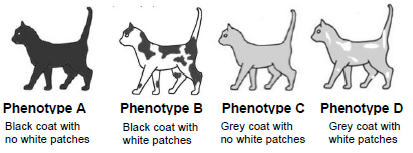
2.5.1 Name the type of cross represented here. (1)
2.5.2 Give a reason for your answer to QUESTION 2.5.1. (1)
2.5.3 Give the:
- Genotype of phenotype D (2)
- Phenotypes of the parents (2)
2.5.4 Explain why all the kittens having a black coat with white patches may not have the same genotype. (2)
2.5.5 State Mendel's principle of segregation. (3)
[50]
QUESTION 3
3.1 Some maize crops have been genetically modified to be herbicide resistant. This means that when the farmer sprays his crop field with herbicide to kill weeds, the maize will not be affected. The milkweed plant is a weed that grows between maize crops. The monarch butterfly lays its eggs on the milkweed plant. The young feed on the leaves of the milkweed plant.
Scientists investigated if the increased use of herbicides affect the number of monarch butterfly colonies in a crop field.
They planted herbicide resistant maize crops from1994 to 2010. From 1998 they started applying the herbicides to kill the weeds. Every year they counted the number of monarch butterfly colonies.
The graph below shows the data they collected from 1994 to 2010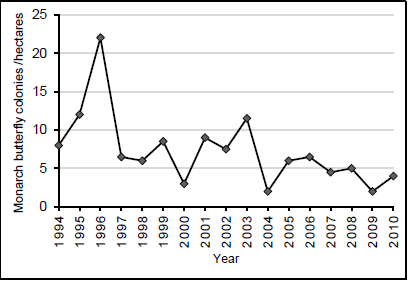
3.1.1 Provide a title for the graph above. (1)
3.1.2 Identify the:
- Independent variable (1)
- Dependent variable (1)
3.1.3 Using evidence from the graph, explain why the herbicides are the only factor that has caused the decrease in the monarch butterfly colonies. (2)
3.1.4 What is a genetically modified organism? (2)
3.1.5 Explain ONE economic advantage of the use of herbicide resistant maize crops for a farmer. (2)
3.2 Read the extract below.
In Brazil there are different lizard species that feed on termites.
|
3.2.1 State why the species of lizards with larger body size did not survive on the small islands. (1)
3.2.2 Explain why there was no gene flow between the populations of a species of lizards after the floods in 1996? (2)
3.2.3 Use Darwin’s theory of natural selection to explain why the population of the Gymnodactylus amarali lizards in the islands have larger heads. (5)
3.2.4 Describe how it can be proven that the species of lizard on the different islands are the same species as that on the mainland. (2)
3.3 The diagrams below show the skull of a human and a gorilla.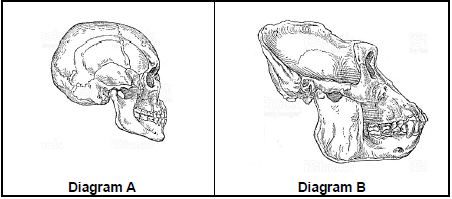
3.3.1 Give the scientific name of the organism in Diagram A. (1)
3.3.2 Explain why the teeth are larger in the skull in Diagram B. (2)
3.3.3 Apart from the size of the teeth, tabulate THREE other observable structural differences between the skull of a human and a gorilla. (7)
3.3.4 List TWO structural similarities between the forelimb of a human and gorilla. (2)
3.4 The diagram below represents the possible evolution of humans, as well as the time period for the evolution of bipedalism, use of stone tools and use of fire.
3.4.1 Name the TWO genera that were bipedal but did not use fire. (2)
3.4.2 When did the A. afarensis evolve? (1)
3.4.3 How long did it take for the hominin species to start using fire after they were bipedal? (2)
3.4.4 Explain TWO skeletal changes that took place to enable bipedalism. (4)
3.4.5 Mrs. Ples is a hominin fossil discovered in South Africa in1947.
- Give the full scientific name for Mrs Ples. (1)
- Where in South Africa was Mrs. Ples discovered? (1)
- Name ONE scientist that discovered Mrs. Ples. (1)
3.5 The map below shows the origins and movements of early humans according to the ‘Out of Africa’ hypothesis. The age of the oldest fossils found on each continent is also indicated below the name.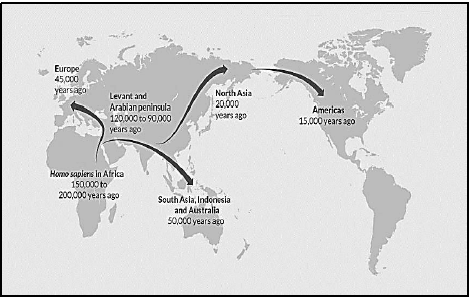
3.5.1 State the ‘Out of Africa’ hypothesis. (2)
3.5.2 Give TWO lines of evidence used to support the Out of Africa hypothesis. (2)
3.5.3 According to the map, which continent was the last to be colonised by early humans? (1)
3.5.4 Calculate the difference in the age of the oldest fossils found in Africa and those found in Europe? Show ALL your workings. (2)
[50]
TOTAL SECTION B: 100
GRAND TOTAL: 150

